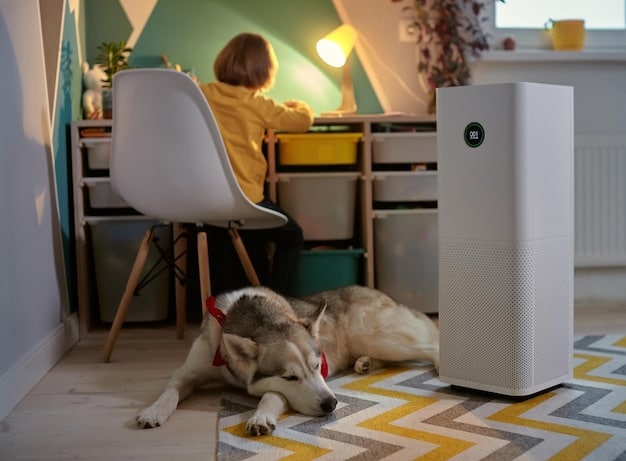Hypoallergenic Dogs 2025: Breed Profiles & Allergy Management Tips

Hypoallergenic dog breeds, while not entirely allergen-free, produce fewer allergens than other breeds, making them suitable for allergy sufferers; this article explores updated breed profiles and provides practical allergy management tips for 2025.
For allergy sufferers, the dream of owning a dog can often feel out of reach. However, certain breeds, known as hypoallergenic dog breeds, produce fewer allergens, offering a glimmer of hope. This guide explores popular hypoallergenic breeds and offers updated allergy management strategies for 2025.
Understanding Hypoallergenic Dog Breeds
The term “hypoallergenic” often implies that these dog breeds are entirely allergen-free. However, that’s not entirely accurate. These breeds simply produce fewer allergens, primarily through less shedding and dander production.
It’s important to understand that allergies are triggered by proteins found in a dog’s saliva, urine, and dander (dead skin flakes). Hypoallergenic breeds reduce exposure to these allergens, making living with them more manageable for allergy sufferers.
How Hypoallergenic Breeds Minimize Allergens
Several characteristics contribute to a breed’s hypoallergenic status. These include coat type, shedding frequency, and grooming needs. Breeds with non-shedding coats, like Poodles, tend to trap dander, preventing it from spreading into the environment.
Regular grooming is also crucial. Bathing and brushing help remove loose hair and dander, further reducing allergen levels. Choosing the right breed and maintaining a consistent grooming routine can make a significant difference for allergy sufferers.
- Coat Type: Curly or wiry coats trap dander more effectively than smooth, short coats.
- Shedding Frequency: Low-shedding breeds release less dander into the environment.
- Grooming Needs: Regular grooming removes allergens and keeps the dog’s coat healthy.
Ultimately, managing allergies involves a multi-faceted approach. This includes selecting a suitable breed, maintaining a clean home environment, and consulting with an allergist for personalized advice.

Top Hypoallergenic Dog Breeds in 2025
Several dog breeds are known for their hypoallergenic qualities. These breeds vary in size, temperament, and grooming requirements, so it’s essential to choose one that fits your lifestyle and preferences.
Here are some of the most popular and recommended hypoallergenic dog breeds for 2025, each offering unique benefits for allergy sufferers.
Poodle (Standard, Miniature, and Toy)
Poodles are intelligent, active, and highly trainable. Their curly, non-shedding coats make them an excellent choice for people with allergies. Regular grooming is essential to prevent matting.
Available in three sizes, Poodles can fit into various living situations. They require plenty of exercise and mental stimulation to stay happy and healthy. Their hypoallergenic coat is a major plus for allergy sufferers, requiring regular professional grooming.
Bichon Frise
Bichon Frises are small, cheerful dogs with a fluffy white coat. They are known for being friendly and adaptable, making them great companions. Their non-shedding coat requires regular grooming to prevent matting.
These dogs are playful and enjoy spending time with their families. Their hypoallergenic coat makes them a popular choice for allergy sufferers, but regular grooming is a must to maintain their coat’s health and appearance.
Shih Tzu
Shih Tzus are affectionate and playful dogs that bond strongly with their families. Their long and silky fur requires regular grooming to prevent matting and tangles. Many owners opt to keep their coat trimmed short for easier maintenance.
Despite their long coat, Shih Tzus are considered hypoallergenic because they don’t shed much. Regular bathing and brushing are essential to minimize allergens. This breed thrives on companionship and makes a wonderful family pet.
- Poodle: Intelligent, active, and available in various sizes.
- Bichon Frise: Cheerful, friendly, and adaptable.
- Shih Tzu: Affectionate, playful, and bonds strongly with family.
Choosing the right breed involves research and careful consideration. Meeting the dog in person before bringing it home can also help assess your allergic reaction.
Grooming and Maintenance for Hypoallergenic Dogs
Regular grooming is essential for maintaining the hypoallergenic qualities of these breeds. Proper grooming not only keeps the dog looking their best but also minimizes allergen production.
A consistent grooming routine includes bathing, brushing, and professional grooming appointments. The frequency and specific techniques will vary depending on the breed and coat type.
Bathing Techniques
Regular bathing helps remove loose hair and dander from the dog’s coat. Use a hypoallergenic shampoo to avoid irritating the dog’s skin. Bathing frequency depends on the breed and their lifestyle, but generally, once every two to three weeks is sufficient.
When bathing, ensure the dog is thoroughly rinsed to remove all shampoo residue. Pat the dog dry with a towel and avoid using a high-heat setting on a dryer, which can dry out their skin.
Brushing Methods
Brushing helps remove loose hair and prevent matting. The type of brush needed depends on the dog’s coat type. For example, Poodles and Bichon Frises benefit from slicker brushes and metal combs to prevent matting.
Brush your dog several times a week to keep their coat healthy and reduce shedding. Regular brushing also stimulates blood flow to the skin, promoting a healthy coat.
- Regular Bathing: Helps remove loose hair and dander.
- Consistent Brushing: Prevents matting and reduces shedding.
- Professional Grooming: Essential for maintaining coat health and minimizing allergens.
Remember, consistency is key. A well-groomed dog is not only more comfortable but also produces fewer allergens, making them easier to live with for allergy sufferers.
Creating an Allergy-Friendly Home Environment
Even with a hypoallergenic dog breed, maintaining an allergy-friendly home environment is crucial for managing symptoms. Reducing allergens in your home can significantly improve your quality of life.
Simple changes like regular cleaning, using air purifiers, and designating dog-free zones can make a big difference in minimizing allergen exposure.
Regular Cleaning Practices
Vacuuming regularly, especially in areas where your dog spends the most time, is essential. Use a vacuum cleaner with a HEPA filter to trap allergens effectively. Mop hard floors and wash bedding frequently to remove dander and other allergens.
Pay attention to upholstered furniture and curtains, as these can trap allergens. Consider using allergen-impermeable covers for furniture and washing curtains regularly.
Air Purifiers and Filtration
Air purifiers with HEPA filters can help remove allergens from the air. Place air purifiers in rooms where you spend the most time, such as the bedroom and living room. Change filters regularly to maintain their effectiveness.
Consider upgrading your home’s HVAC system with high-efficiency filters to capture more allergens. Regularly inspect and clean air ducts to prevent the buildup of dust and other allergens.
Designating Dog-Free Zones
Creating dog-free zones, especially in the bedroom, can reduce allergen exposure during sleep. Keep your dog off furniture and limit their access to certain areas of the house.
Use barriers or closed doors to keep your dog out of designated allergy-free zones. Regularly clean these areas to minimize any allergens that may have made their way in.

- Regular Vacuuming: Use a HEPA filter to trap allergens effectively.
- Air Purifiers: Remove allergens from the air.
- Dog-Free Zones: Limit allergen exposure in specific areas.
By implementing these strategies, you can create a more comfortable and allergy-friendly home environment, allowing you to enjoy the companionship of your dog with fewer symptoms.
Managing Dog Allergies: Medical and Lifestyle Approaches
For some individuals, even with a hypoallergenic dog breed and an allergy-friendly home, medical treatments may still be necessary to manage allergy symptoms effectively.
Consulting with an allergist is crucial for developing a personalized treatment plan. Medical options range from over-the-counter remedies to prescription medications and allergy shots.
Over-the-Counter Remedies
Antihistamines can help relieve symptoms like sneezing, itching, and runny nose. Decongestants can help clear nasal congestion. Nasal sprays can reduce inflammation and relieve nasal symptoms.
These remedies provide temporary relief but do not address the underlying cause of allergies. It’s important to follow the recommended dosage and consult with a healthcare professional if symptoms persist.
Prescription Medications
Allergists may prescribe stronger antihistamines, nasal corticosteroids, or other medications to manage allergy symptoms. These medications can provide more effective relief than over-the-counter options but may have side effects.
Follow your allergist’s instructions carefully when taking prescription medications. Regular check-ups can help monitor the effectiveness of the treatment and adjust the dosage if necessary.
Allergy Shots (Immunotherapy)
Allergy shots involve a series of injections containing small amounts of allergens. Over time, the body becomes desensitized to the allergens, reducing allergy symptoms. Immunotherapy can be a long-term solution for managing dog allergies.
The treatment typically lasts for several years and requires regular visits to the allergist. While immunotherapy can be effective, it’s important to discuss the potential risks and benefits with your healthcare provider.
Ultimately, managing dog allergies effectively requires a combination of medical treatments and lifestyle adjustments. Working closely with an allergist can help you develop a personalized plan that addresses your specific needs.
Future Trends in Hypoallergenic Dog Breeding
The field of hypoallergenic dog breeding is continually evolving, with new research and techniques aimed at reducing allergens. Advances in genetic testing and selective breeding are paving the way for even more allergy-friendly dogs in the future.
Understanding these trends can help allergy sufferers make informed decisions about choosing a dog and managing their allergies.
Genetic Testing and Selective Breeding
Genetic testing can identify dogs with specific genes associated with lower allergen production. Breeders can use this information to selectively breed dogs that are more likely to be hypoallergenic.
This approach aims to produce dogs that consistently produce fewer allergens, providing a more reliable option for allergy sufferers. As genetic testing becomes more accessible, it is likely to play an increasingly important role in hypoallergenic dog breeding.
Advanced Grooming Technologies
New grooming technologies, such as specialized vacuums and allergen-reducing shampoos, are being developed to further minimize allergen exposure. These technologies can help maintain a cleaner home environment and reduce the need for frequent bathing.
Self-cleaning dog beds and air filtration systems designed specifically for pet allergens are also becoming more popular. These innovations can significantly improve the quality of life for both allergy sufferers and their dogs.
Research on Allergen Reduction
Ongoing research is focused on understanding the specific proteins that cause dog allergies and developing strategies to reduce their production. This research may lead to new treatments or breeding techniques that further minimize allergens.
Studies are also exploring the potential of using probiotics or other dietary supplements to reduce allergen production in dogs. These advancements offer hope for even more effective allergy management in the future.
- Genetic Testing: Identify dogs with lower allergen production genes.
- Grooming Technologies: Minimize allergen exposure with specialized tools.
- Allergen Reduction Research: Develop new strategies to reduce allergen production.
By staying informed about these future trends, allergy sufferers can anticipate and benefit from the ongoing improvements in hypoallergenic dog breeding and allergy management.
| Key Point | Brief Description |
|---|---|
| 🐶 Breed Choice | Selecting a hypoallergenic breed minimizes allergen exposure. |
| 🛁 Grooming | Regular grooming reduces dander and allergens. |
| 🏠 Home Environment | Cleanliness and air purifiers help manage allergens. |
| 🩺 Medical Options | Antihistamines and allergy shots can relieve symptoms. |
Frequently Asked Questions
▼
No, hypoallergenic dogs are not 100% allergy-free. They produce fewer allergens, making them more suitable for allergy sufferers, but reactions can still occur. Managing your environment is key.
▼
Poodles, Bichon Frises, and Shih Tzus are often recommended for severe allergies due to their low-shedding coats. However, individual reactions can vary, so it’s best to spend time with the dog beforehand.
▼
Grooming frequency depends on the breed, but generally, bathing every 2-3 weeks and brushing several times a week is recommended. Professional grooming every few months is also a good idea.
▼
Yes, air purifiers with HEPA filters can effectively remove allergens from the air, reducing allergy symptoms. Place them in frequently used rooms and change the filters regularly for optimal performance.
▼
Yes, ongoing research is exploring new dietary supplements and breeding techniques to reduce allergen production in dogs. Immunotherapy (allergy shots) remains a long-term medical solution.
Conclusion
Choosing a hypoallergenic dog breed can be a great way for allergy sufferers to enjoy the companionship of a dog. By understanding the specific needs of these breeds and implementing effective allergy management strategies, you can create a comfortable and enjoyable living environment for both you and your furry friend.





